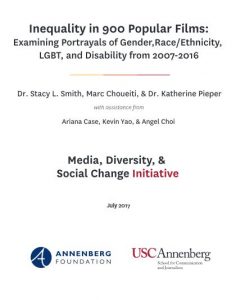 LOS ANGELES, Calif.– According to Professor Stacy L. Smith, author of a new study on inclusion in 900 top movies of the last decade, “Privilege still speaks, as white, straight, able-bodied men remain the norm on screen in film.”
LOS ANGELES, Calif.– According to Professor Stacy L. Smith, author of a new study on inclusion in 900 top movies of the last decade, “Privilege still speaks, as white, straight, able-bodied men remain the norm on screen in film.”
The report “Inequality in 900 Popular Films,” released today, from Smith and the Media, Diversity & Social Change (MDSC) Initiative at USC Annenberg, reveals how little top movies have changed when it comes to the on-screen prevalence and portrayal of females, underrepresented racial/ethnic groups, the LGBT community and individuals with disabilities. The study is the largest and most comprehensive intersectional analysis of characters in motion picture content to date. The investigation examined the 900 top films from 2007 to 2016 (excluding 2011), analyzing 39,788 characters for gender, race/ethnicity, LGBT status and disability. The analysis included the 100 top movies of 2016. The results reveal that there has been little to no meaningful change in the representation of these diverse groups in popular movie content since 2015.
The top-line statistics show just how much progress has stalled in Hollywood. Across all 9 years examined, less than one-third of speaking characters on screen were girls/women, including just 31.4% of characters in the 100 top movies of 2016. Characters from underrepresented racial/ethnic groups were 29.2% of all characters in the top-grossing films of 2016, which is not different from 2015, but does reflect an increase from 2007. While there has been a decrease in the percentage of White characters from 2007, there has been no meaningful change in the percentage of Black/African American, Hispanic/Latino, Asian/Asian American, or Mixed Race/other characters since that year.
LGBT-identified characters represented a mere 1.1% of all speaking characters, a percentage not different from 2015. The findings do reveal that there was an uptick in the portrayal of gay males from 2015. An LGBT lead or co-lead character appeared in only 3 films of the 300 studied between 2014 and 2016. Characters with disabilities filled only 2.7% of all speaking roles, which is not different from last year, when the researchers began studying this group. However, there was an increase in female speaking characters with disabilities from the prior year.
“These are sustained and systemic problems. It is impossible to look at this data without concluding that much of the advocacy surrounding on-screen representation over the past few years has not been successful,” said Smith, founding director of the MDSC Initiative. “Perhaps we will see more positive trends in the future, given the current level of conversation and success of certain movies this year. However, until solutions focus on changing the exclusionary hiring practices and countering explicit and implicit biases in Hollywood, it is difficult to expect real change anytime soon.”
The report’s “invisibility analysis” reveals that beyond the overall statistics, Hollywood fails to portray speaking characters from diverse groups altogether. Of the 100 top films of 2016, 25 films featured no Black/African-American characters, 44 included no Asian or Asian-American characters, and 54 depicted no Hispanic/Latino characters. Further, 38 films portrayed not a single character with a disability and 76 failed to include one lesbian, gay, bisexual or transgender character. “Doesn’t everyone deserve to have their stories and voices reflected in one of our most popular forms of entertainment?” asked Smith. “These findings reveal that the erasure of different groups is still acceptable to some—we need look no further than film to see a vision of America that no longer exists. Film paints a distressing portrait of exclusion.”
Looking to leading or co leading roles, 34 of the 100 top films in 2016 featured a female at the center. Just three of these leading ladies were from underrepresented racial/ethnic groups—identical to what the report found in 2015. Eight films had a female lead or co-lead 45 years of age or older, and only 1 was from an underrepresented racial/ethnic group. Fourteen movies featured an underrepresented lead or co lead character, the same as 2015.
“The deficits we see on screen are worse behind the camera,” said Smith. Out of the 1,006 directors hired on the 900 films studied, just 4.1% were females. Only 5.6% of the directors were Black or African American and 3% were Asian or Asian American. Three Black or African-American women and two Asian women worked as directors across the 900 movies. “When we look intersectionally at directors, that’s where we see just how exclusionary Hollywood is when it comes to the hiring process,” said Smith. “The image of a female director seems to be that of a White woman.”
The portrayal of characters was also examined, focusing on stereotyping and sexualization. Female characters were far more likely than their male counterparts to be depicted in sexually revealing clothing, with some nudity, and to be referenced as attractive. Teenage female characters (age 13 to 20) were just as likely as young adult (age 21-39) female characters to be sexualized.
The report also offers solutions to what Smith has previously referred to as the “epidemic of invisibility” in film. These strategies are targeted at studios, production companies, film festivals, film schools, top talent, and even consumers who want to advocate for change in innovative and practical ways. Smith’s Initiative not only evaluates media content but works with individuals and companies to implement these strategies.
The study is the latest from the Media, Diversity, & Social Change Initiative, which produces an updated report annually. Read the full report here.











